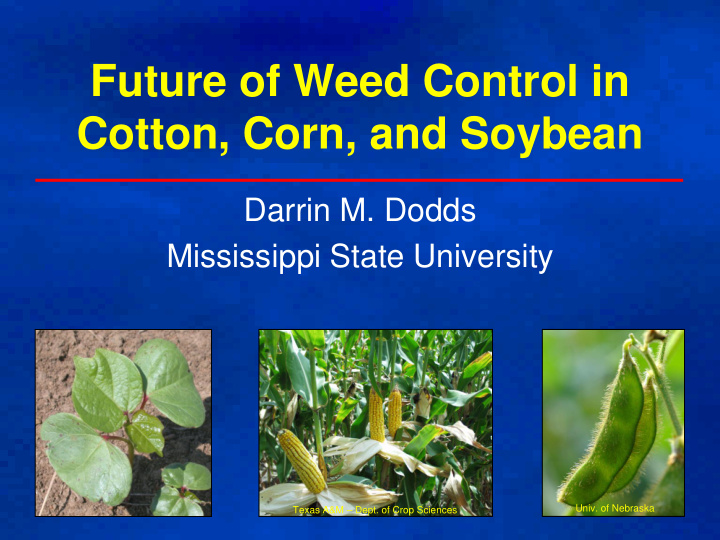



Future of Weed Control in Cotton, Corn, and Soybean Darrin M. Dodds Mississippi State University Texas A&M – Dept. of Crop Sciences Univ. of Nebraska
Current State of Biotech Crops • 10 million farmers in 22 countries • Area planted to biotech crops has increased 60-fold in 11 years • 100 million hectares – 80% glyphosate resistant
Where Are We Today? • Cotton “ Glyphosate is as important to world – 99% of cotton in Mississippi is RR or RF agriculture as penicillin is to human health ” – 93% of U.S. cotton is RR or RF - Dr. Stephen Powles – Science 2007 • Corn – 90+% of Mississippi corn is RR – 63% of U.S. corn is herbicide resistant or stacked gene • Soybean – 96% of Mississippi soybeans are RR – 91% of U.S. soybeans are RR
Herbicide Use in Cotton 100 Glyphosate 80 % Treated Acres Fluometuron 60 40 2,4-D 20 Flumioxazin 0 1997 1999 2001 2003 2005 2007 Year Natl. Ag. Stat. Service
Development of Current Weed Control Technology • Glyphosate – Weed control properties identified in 1970 – Glyphosate-resistance gene first inserted into plants in 1986 • Metolachlor – Synthesized in 1972 • Dicamba – U.S. patent awarded in 1958 • 2,4-D – Synthesized in 1941 • Atrazine – Synthesized in 1952
Where Are We Going? • Many of the new options in weed control in the next 3-5 years will be in the form of traits – Expand uses of currently available herbicides – Expand use of currently available traits • New herbicide discovery – Time consuming – Very expensive • Integrate new herbicides as they are developed
Glytol/H2 • Developed by Bayer CropScience • Glytol – Glyphosate-resistance similar to RR Flex – Different gene and promoter than RR Flex • H2 – Glyphosate/glufosinate resistance
Glytol/H2 • Cotton: – Glytol – 2009 – H2 – 2010 – BG II/H2 – 2011 – Twinlink/H2 – 2012 • Soybeans: – Glytol + HPPD – 2014 – Glytol + HPPD + Liberty Link – 2016
Liberty Link • Bayer trait – Available in cotton • Acreage very limited in Mid-South – Licensed to Monsanto for use in corn and soybean – Part of SmartStax™ package • Liberty Link soybeans available in 2009
Liberty Link • Use of the Liberty Link system will require a change in mindset • Like anything, has limitations • Increasing rate will not be cost effective or efficacious
Optimum GAT • Glyphosate ALS Tolerance • Developed by DuPont • Different glyphosate resistance gene than Monsanto – Derived from soil bacterium – Enzyme binds to glyphosate and breaks it down into non-toxic metabolites • ALS enzyme insensitive to all 5 classes of ALS- chemistry – Proprietary DuPont discovery
Optimum GAT • Corn: 2010 – Plans in place to include Bayer’s Liberty Link trait with Optimum GAT – Glyphosate/Glufosinate/ALS • Soybean: 2011 • Cotton: ???
Optimum GAT • Pros: – Competition in the marketplace – Allows for increased utility of ALS-inhibiting herbicides • Cons: – Allows for increased utility of ALS-inhibiting herbicides – Variety/hybrid introgression
DHT • DowAgrosciences Herbicide Trait • 2,4- D + “Fop” resistance – NOT dicamba resistance – NOT “Dim” resistance • Corn: 2012 – Offered in conjunction with SmartStax™ package • Cotton and Soybean: 2013 – Offered in conjunction with glyphosate-resistance
DHT • Pros: – Use of additional chemistry – “Protection” from 2,4 -D drift • Cons: – Potential for off-target movement of herbicides – Education regarding product selection – Crops becoming weeds
HPPD Resistance • 4-Hydroxyphenyl Pyruvate Dioxygenase inhibitors • Balance Pro, Callisto, Impact, Laudis • Will be offered in a three-way stack in soybeans – Glyphosate/glufosinate/HPPD • Potential for development in cotton
Dicamba Tolerance • University of Nebraska – Technology based on a soil bacteria gene discovered at a dicamba manufacturing plant • DMO gene • Soybeans have displayed tolerance of up to 5 lbs ai/acre • Tobacco plants with tolerance of up to 25 lb ai/acre
Future Options • Three-way herbicide resistance from Dupont – Soybeans – Discovery phase • Dicamba + glufosinate tolerant cotton from Monsanto – Proof of concept phase • Paraquat resistance??? • PPO-resistance??? • New active ingredients and modes of action
Conclusions • For foreseeable future, weed control will be trait based • New herbicides will be incorporated into existing systems • Quest for next glyphosate is underway • “Weed control in the early 2000’s was as easy as it will ever be” – Dr. Larry Steckel – Delta Farm Press 2008
Questions Carolyn Kaster – Asspc. Press University of Nebraska 2001
Recommend
More recommend